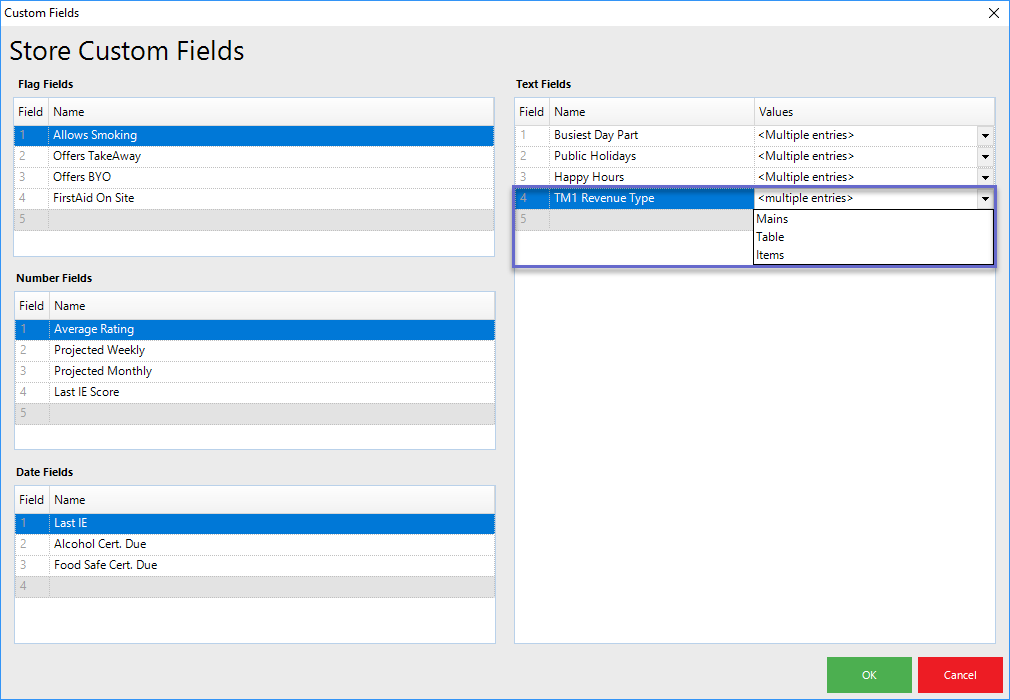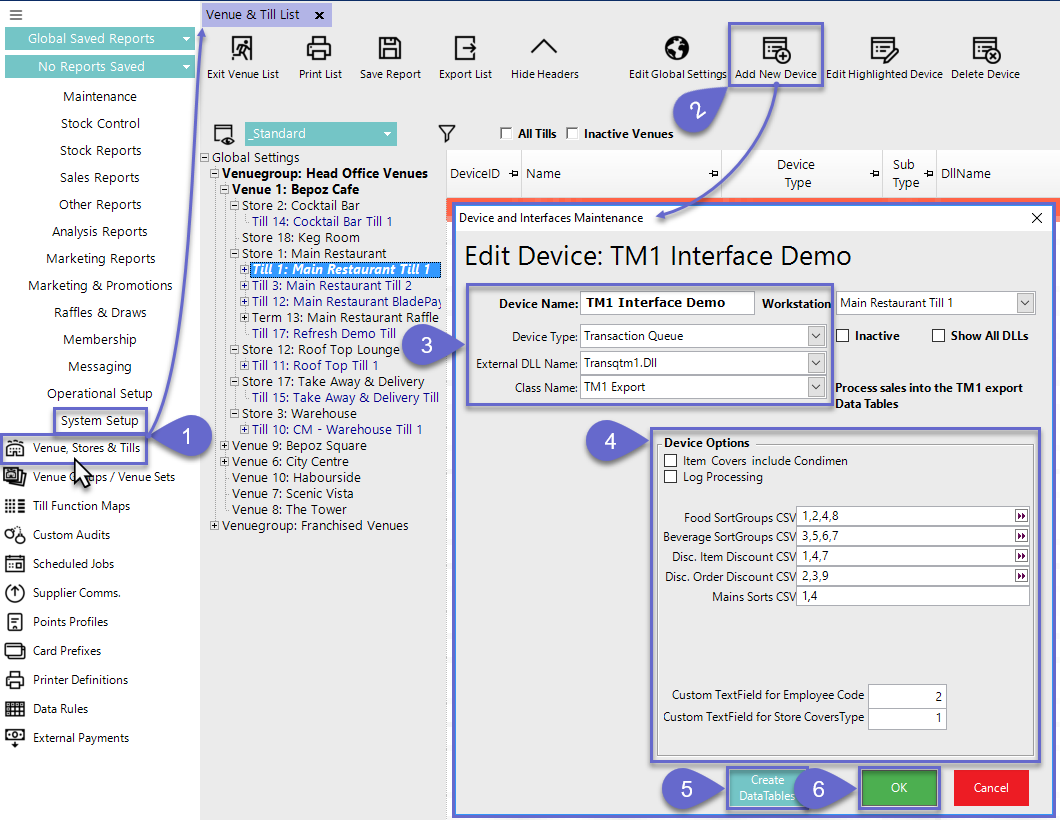This article outlines a step-by-step guide to setting up the TM1 Interface through a Scheduled Job and other relevant configurations within BackOffice.
This article outlines a step-by-step guide to setting up the TM1 Interface through a Scheduled Job and other relevant configurations within BackOffice.
About
- TM1 is a financial package used by large businesses; it is enterprise planning software used to implement collaborative planning, budgeting and forecasting solutions, as well as analytical and reporting applications
- Using a Transaction Queue DLL, this interface copies two (2) file formats & contents, creates two (2) new database tables within the Bepoz Database with the data to be sent, and a Stored Procedure is created to allow for retrieval of the data from the tables
Prerequisites
- Minimum Bepoz version of v4.7.1.5 and onwards
- In order to access the device setup; the following Operator pre-requisites have to be fulfilled
-
Operator Maintenance 'General' Tab - System Setup Flags - "Access Venue Stores & Tills flag
- System Setup Flags - "Maintain Venue Stores & Tills flag
TM1 Transaction Queue
- The interface itself is maintained using a TransQueue Device running at the Head Office and processes every Transaction received
- This Transaction Queue will Add and Update Records in the Database Tables called "SG_SalesDaily", "SG_DiscDaily" and "SC_PaymentHourly"
Device Setup Prerequisite
Store Custom Fields
- To prepare for a setting within the Transaction Queue Device Options, a Custom Text field will need to be configured in Store Custom Info as follows:
- Label the Custom Text Field "TM1 Revenue Type"
- Options for the aforementioned Text Field must be "Mains", "Table", and "Items"

Device Setup
- After logging into BackOffice, complete the following steps to create & configure a TM1 Transaction Queue:
- Navigate to the System Setup component in the sidebar, expand, and select Venue, Stores & Tills to open the Venue & Till List Tab
- Highlight the Head Office Server Workstation and click on the Add New Device button in the header; when prompted select 'Blank Device' and a New Device and Interfaces Maintenance window will open
- Enter a Device Name, set the Device Type to 'Transaction Queue', the External DLL Name to 'Transqtm1.Dll', and the Class Name to 'TM1 Export'
- Configure the Device Options as required:
- Item Covers include Condiment - enable this flag to include the Condiments Sold in the count and balance to the Till Summaries Report; when calculating covers from Mains or Items, it's best not to do so
- Log Processing - when enabled, two (2) Logs will be written each day to the following directory: LocalData\TM1Logs; 1 for DiscDaily and 1 for SalesDaily exports
- Food SortGroups CSV - in a comma delimited string, list the System's SortGroups (from Global Settings) that constitute Food Items
- Beverage SortGroups CSV - in a comma delimited string, list the System's SortGroups (from Global Settings) that constitute Beverage Items
- Disc. Item Discount CSV - in a comma delimited string, list the Item Discount Totalizers that are to be reported as Discounts (as opposed to Comps); if left blank, ALL Discount Totalizers will be treated as Comps
- Disc. Order Discount CSV - in a comma delimited string, list the Order Discount Totalizers that are to be reported as Discounts (as opposed to Comps); if left blank, ALL Discount Totalizers will be treated as Comps
- Mains Sorts CV - in a comma delimited string, list the SortTypes (from Global Settings) that signify the Mains for the purposes of Covers Reporting
- Custom TextField for Employee Code - using an Operator Custom Text Field as an "Employee Code", set the number of the Custom Text here
- Custom TextField for Store CoversType - after configuring Store Custom Info with text options for "TM1 Revenue Type", set the number of the Custom Text option here
- The Custom Text options to be used are: Items, Table, and Mains
- If the correct value for the Store Export Codes isn't set, the TM1 Export will default to Items
- Clicking the Create DataTables button will create the blank Tables in the Bepoz Database
- Click OK to save the Transaction Queue

Database Tables
SG_SalesDaily
- This is Sales Data by Location, by Serving Period, by Date
- The Data contained is broken up by Cash / Comp / Total
- Then each of those divisions is also broken up by Food / Beverage / Other / Covers
- There is also a Discount Field
- All Totals shown are Gross, with Discounts added back in
- "RvcNo" is determined by the Venue Setting for Reslink Export Code (probably Store Export Code)
- LocationID is a Venue SiteCode
SG_DiscDaily
- This is Payment Data by Location, by Date, by Employee, by TransType. by Payment Type
- The Data contained is LineCount and LineTotal
- The TransType Field is one of Payment / Discount / ServiceCharge / Tip
- The Payment Type is either one of the actual Bepoz Payment types, a Product Promotion name, a Voucher name (only non-ProdPromo types) or it is a Discount Totalizer for discounts that are not triggered by Vouchers or Product Promotions
- "RvcNo" is determined by the Venue Setting for Reslink Export Code (probably Store Export Code)
- LocationID is a Venue SiteCode
- EmployeeID is Operator ID
- Employee Code is determined by Device Setup
- Custom Code is ProdPromotion or Voucher = Custom Text Field 1
SG_PaymentHourly
- This is Payment Data generated based on TrxDate, Rvcno TimeBreakDown, LocationID, ProductID, Size
- TrxDate is the datetime of the product sales for the time period
- Rvcno is the Store Export Code_1 field of the SmartPOS till store for the transaction
- LocationID is the Venue SiteCode
- ProductID is the ProductID in Bepoz
- Size is the Product Size 1-10
Developer Notes
Comp vs. Discount
- Some organizations use a concept of Comps which are Complimentary items given to customers
- These may be a Voucher (which produces a Discount), a simple Discount from Manual Key or Prod Promo, or a transfer to a Manager Card
- As Bepoz tracks all discounts given via Discount Totalisers, these can be used to access the Data required
- In the Device setup, there are 2 fields that are used to define which Item Discount Totalizers and which Order Discount Totalizers are to be considered as Comps - as opposed to Discounts
- These fields can be left blank for All to be Comps
- These fields are set up as Comma Separated Values (CSV)
- E.g., to set values 1 and 2 and 4 and 8 then enter "1,2,4,8" into the field
- Both Tables use these setups to determine whether a Discount applied is to be considered a Comp Payment and report accordingly
Food / Beverage / Other
- In the Device setup, there are 2 fields that are used to define which Sort Groups constitute both the Food Items and Beverage Items
- Any Item in a SortGroup other than those listed are deemed to be Other
- These Fields are set up as Comma Separated Values (CSV)
- E.g., to set values 1 and 2 and 4 and 8 then enter "1,2,4,8" into the field
Table Sales
- The SalesDaily table will only include Sales for completed Transactions; including all simple Cash and Comp transactions
- For Table Sales, however, the totals will not be affected until the Table is closed
- At that time the whole of the Table Items are added to the Data Table in the current Shift/Till
- The DiscDaily Table is basically a Payment report and will reflect the Table Payments as they are entered
